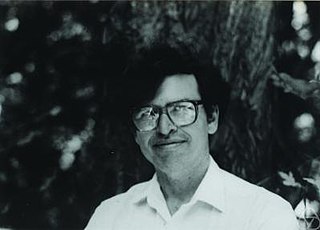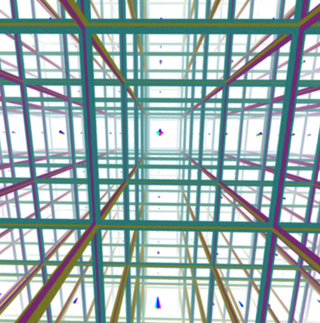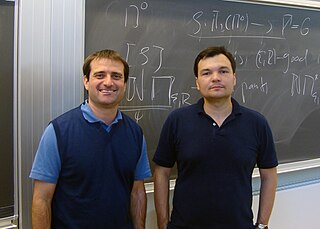Related Research Articles

William Paul Thurston was an American mathematician. He was a pioneer in the field of low-dimensional topology and was awarded the Fields Medal in 1982 for his contributions to the study of 3-manifolds.
In mathematics, Thurston's geometrization conjecture states that each of certain three-dimensional topological spaces has a unique geometric structure that can be associated with it. It is an analogue of the uniformization theorem for two-dimensional surfaces, which states that every simply connected Riemann surface can be given one of three geometries . In three dimensions, it is not always possible to assign a single geometry to a whole topological space. Instead, the geometrization conjecture states that every closed 3-manifold can be decomposed in a canonical way into pieces that each have one of eight types of geometric structure. The conjecture was proposed by William Thurston, and implies several other conjectures, such as the Poincaré conjecture and Thurston's elliptization conjecture.
In mathematics, a Haken manifold is a compact, P²-irreducible 3-manifold that is sufficiently large, meaning that it contains a properly embedded two-sided incompressible surface. Sometimes one considers only orientable Haken manifolds, in which case a Haken manifold is a compact, orientable, irreducible 3-manifold that contains an orientable, incompressible surface.

In mathematics, a 3-manifold is a topological space that locally looks like a three-dimensional Euclidean space. A 3-manifold can be thought of as a possible shape of the universe. Just as a sphere looks like a plane to a small and close enough observer, all 3-manifolds look like our universe does to a small enough observer. This is made more precise in the definition below.
In mathematics, more precisely in topology and differential geometry, a hyperbolic 3-manifold is a manifold of dimension 3 equipped with a hyperbolic metric, that is a Riemannian metric which has all its sectional curvatures equal to −1. It is generally required that this metric be also complete: in this case the manifold can be realised as a quotient of the 3-dimensional hyperbolic space by a discrete group of isometries.
In the mathematical subfield of 3-manifolds, the virtually fibered conjecture, formulated by American mathematician William Thurston, states that every closed, irreducible, atoroidal 3-manifold with infinite fundamental group has a finite cover which is a surface bundle over the circle.
In mathematics, the Smith conjecture states that if f is a diffeomorphism of the 3-sphere of finite order, then the fixed point set of f cannot be a nontrivial knot.

In mathematics, the surface subgroup conjecture of Friedhelm Waldhausen states that the fundamental group of every closed, irreducible 3-manifold with infinite fundamental group has a surface subgroup. By "surface subgroup" we mean the fundamental group of a closed surface not the 2-sphere. This problem is listed as Problem 3.75 in Robion Kirby's problem list.
In mathematics, the tameness theorem states that every complete hyperbolic 3-manifold with finitely generated fundamental group is topologically tame, in other words homeomorphic to the interior of a compact 3-manifold.

In the mathematical field of knot theory, the hyperbolic volume of a hyperbolic link is the volume of the link's complement with respect to its complete hyperbolic metric. The volume is necessarily a finite real number, and is a topological invariant of the link. As a link invariant, it was first studied by William Thurston in connection with his geometrization conjecture.
In geometry, Thurston's geometrization theorem or hyperbolization theorem implies that closed atoroidal Haken manifolds are hyperbolic, and in particular satisfy the Thurston conjecture.
In mathematics, more precisely in group theory and hyperbolic geometry, Arithmetic Kleinian groups are a special class of Kleinian groups constructed using orders in quaternion algebras. They are particular instances of arithmetic groups. An arithmetic hyperbolic three-manifold is the quotient of hyperbolic space by an arithmetic Kleinian group.

Vladimir Marković is a Professor of Mathematics at University of Oxford. He was previously the John D. MacArthur Professor at the California Institute of Technology (2013–2020) and Sadleirian Professor of Pure Mathematics at the University of Cambridge (2013–2014).
In hyperbolic geometry, the ending lamination theorem, originally conjectured by William Thurston, states that hyperbolic 3-manifolds with finitely generated fundamental groups are determined by their topology together with certain "end invariants", which are geodesic laminations on some surfaces in the boundary of the manifold.
In mathematics, the Ahlfors conjecture, now a theorem, states that the limit set of a finitely-generated Kleinian group is either the whole Riemann sphere, or has measure 0.

Ian Agol is an American mathematician who deals primarily with the topology of three-dimensional manifolds.

Daniel T. Wise is an American mathematician who specializes in geometric group theory and 3-manifolds. He is a professor of mathematics at McGill University.

Jeremy Adam Kahn is an American mathematician. He works on hyperbolic geometry, Riemann surfaces and complex dynamics.
Albert Marden is an American mathematician, specializing in complex analysis and hyperbolic geometry.
References
- Dunfield, Nathan; Thurston, William (2003), "The virtual Haken conjecture: experiments and examples", Geometry and Topology , 7: 399–441, arXiv: math/0209214 , doi:10.2140/gt.2003.7.399, MR 1988291, S2CID 6265421 .
- Kirby, Robion (1978), "Problems in low dimensional manifold theory.", Algebraic and geometric topology (Proc. Sympos. Pure Math., Stanford Univ., Stanford, Calif., 1976), vol. 7, pp. 273–312, ISBN 9780821867891, MR 0520548 .